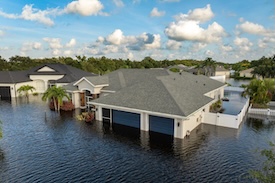Sessions at FGIA Virtual Summer Summit share ways to learn improvement through quality control
Posted on June 24th, 2025
Schaumburg, Illinois – The Fenestration and Glazing Industry Alliance (FGIA) hosted two speakers who shared their knowledge about new research in the fields of Property Resilience Assessment (PRA) and architectural weathering. In a session sponsored by Intertek Building and Construction, presenter Alan Scott spoke about “Designing for the Future | Understanding Resilience in the Built Environment.” This was followed by a presentation by Sean Fowler (Q-Lab), who shared the findings of a recently concluded five-year weathering study conducted by the Society for Protective Coatings (SSPC) Subcommittee C.1.8 on fluoropolymers.
Designing for the Future | Understanding Resilience in the Built Environment

Built Environment Resilience
There are three parts of built environment resilience, said Scott.
1. Safety and security (the ability to keep occupants safe)
2. Integrity (the ability to resist damage)
3. Functionality (the ability to continue functioning during and after a hazard event)
“Sustainability and resilience are two sides of one coin,” said Scott. “We need to improve both.”
There are now many resilience regulations and voluntary disclosures, including:
• The EU’s Corporate Sustainability Reporting Directive regulation
• California SB 261 focused on climate-related financial risk reporting
• ASTM E3429-24, a new guide about Property Resilience Assessment (PRA)
• The LEED v5 resilience assessment released in April
• Codes such as ICC 2027 flood standards
In terms of LEED v5, Scott said there is a requirement to conduct a resilience assessment: a comprehensive assessment for climate resilience, aiming to increase awareness of reduced vulnerability, while striving to ensure long term safety and sustainability. “There is a credit in LEED v5 for having an enhanced resilient site design and a credit for having a resilient space,” he said.
Three stages of PRA
As for the ASTM standard for PRA, this guide was developed with a number of objectives, said Scott, noting its three stages.
• Stage 1: Hazard – screening and identifying hazards (also verifying them): Which natural hazards and future climate hazards present the greatest risk? Use national, state, local and tribal data, said Scott. Risk Footprint is a resource one can use in this process.
• Stage 2: Risk – vulnerability and sensitivity evaluation: How vulnerable is the asset and its occupants to the greatest identified hazards? Vulnerability is a factor of exposure, sensitivity and adaptive capacity. Weigh these to assess one’s hazard impact risk.
• Stage 3: Resilience Measures – making recommendations: For the given hazards and vulnerabilities, what feasible physical and operational resilience measures can reduce risks?
“PRA can be used for new development, but also for risk analysis, like capital improvement planning, operation and maintenance planning,” said Scott. “Also considered is adaptive use or renovation, and assessing those risks upfront.”
Architectural Coatings | Results of Weathering Testing for Preliminary Verified Components Listing (VCL)

The weathering study Fowler discussed was originally conducted to support a new paint specification, but “I thought FGIA [members] would benefit from the study’s findings, as well,” he said. The data validated a 4,000-hour screening test and was a five-year study that concluded in 2024. It involved 13 topcoats from 10 manufacturers. The committee requested a range of durability performance. Each system was tested in four standard colors: white, red, blue and gray. “Around 1,000 coated specimens were collected at our laboratory, anonymized using letter codes,” said Fowler.
The study looked at the correlation between natural and accelerated weathering of industrial maintenance coatings. “It was a fairly substantial study,” said Fowler. Samples were tested via natural outdoor weathering and accelerated outdoor weathering using a series of mirrors. “There was a lot of airflow there to keep them from getting too hot,” said Fowler of the outdoor samples. “We looked at color change and gloss loss.” Measurements were taken every 500 hours in the lab and every six months for the outdoor tests in Florida.
Conclusions of the Study
• Three accelerated methods exhibited good correlation to three years of Florida weathering for both color and gloss.
• White specimen results suggest dirt pickup and microbial degradation are significant in Florida, and this may be applied to colored specimens in some cases.
• In general, total UV dosage in accelerated testing needs to be comparable to outdoor dosage for good correlation. The five year Florida results show many false positive results from accelerated tests at lower dosages.
“The white samples that didn’t fare well after three years certainly didn’t get better after an additional two years of exposure,” said Fowler.
For more coverage about the FGIA Virtual Summer Summit, visit FGIAonline.org/news.
Your trusted industry resource, setting the standards for fenestration and glazing.
###
